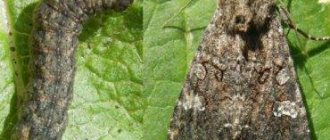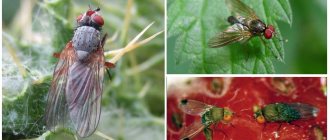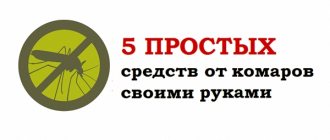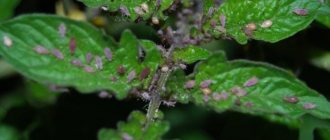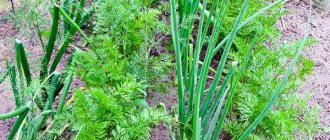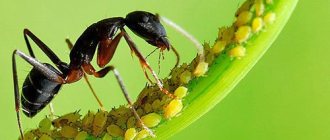Cabbage fly: description
The cabbage fly is a dangerous pest that can destroy cabbage, radish and other cruciferous crops in a short period of time. If you do not prevent the appearance of an insect, it is more difficult to get rid of it. But a competent approach and timely measures will help solve the problem.
It is more difficult to see the cabbage fly itself; its presence is recognized by the appearance of a small worm on the leaves. It looks like a codling moth, but is smaller in size. This is the larva of the cabbage fly that feeds on the roots of crops. Plants begin to wither, dry out, and it seems that they do not have enough water. But watering in this case does not restore the crop.
Video - Cabbage fly:
The cabbage fly is widespread throughout Europe, Siberia, and Central Asia. In Russia, the pest is found almost throughout the entire territory.
The cabbage pest belongs to the family of flower flies. The size reaches 1 cm, insects are not noticeable. Invisible, as they are painted inconspicuously:
- females – light ash;
- males are darker in color.
The cabbage fly is not much different from the house fly. You can recognize it by its dark stripe on the abdomen and three longitudinal stripes on the chest.
The insect causes significant harm to plants, which consists of:
- the larvae must feed, so they constantly consume cabbage root;
- gradually the root system is completely destroyed and the plant dies;
- usually during this period, pupae are formed, and the second generation of insects is born, which move to new plants.
Up to 4 generations can hatch in one growing season. But the crops become stronger and more powerful, so towards the end of summer the damage from insects is not so felt.
Types of cabbage flies
There are 2 types of cabbage fly that are found in the garden:
- spring;
- summer
Spring cabbage fly
Both pests are similar in appearance, although the body color of the second insect is slightly darker. Representatives of the summer group are slightly larger in size (females - up to 7.5 mm, males -5.5) than spring pests (body length up to 6 mm).
When does it come out of winter, and what harm does it cause?
The cabbage fly belongs to the Flowerfly family. The family received this name due to the fact that an adult insect (spring cabbage fly) begins to fly out of the winter during the flowering period of birch, bird cherry, cherry, lilac, and dandelion, when the soil at a depth of 8 centimeters warms up to approximately +10°C (third decade of April - second ten days of May). It feeds on the nectar of which, waiting for the moment of planting seedlings in the ground.
In summer, the individual produces a second generation. They are called summer cabbage flies. Their mass flight begins in the second ten days of June, after the first generation of larvae have passed through the pupation stage. This happens at positive temperatures not lower than + 18 ° C. Under very favorable conditions, an individual can produce a third generation. But the first two remain the most dangerous, while the plants are still young and their roots are tender.
An adult insect (imago) does not differ much in appearance from an ordinary fly. Perhaps in size: somewhat smaller (up to 5.5 - 7.5 mm in length).
The insect itself does not harm the cabbage, does not feed on its tissues and does not pose a danger to plantings until egg laying begins, somewhere in 12 - 14 days after departure.
One adult cabbage plant can lay up to 150 eggs. Moreover, the egg-laying period is long: as long as it lasts for years (6 - 8 weeks), she is able to lay eggs. From which, 7–10 days after laying, white legless larvae emerge, up to 5–6 mm in size, with a black head. So they are the harmful stage of the cabbage fly, eating the roots of the crop up and down, leading to its death.
The larvae feed until pupation for 20–30 days. They are quite difficult to detect. Even after tearing out a plant, it is difficult to immediately notice them. Externally, infected plants, although they look wilted, due to damage to the root hairs and tissues that supply the entire plant with moisture and nutrients, there is a more characteristic sign that it is the cabbage fly that is doing the damage. Gradually drooping plants acquire a grayish-lilac (cyanotic) tint. This is a signal to take drastic measures. The plant is very young, the root system is still weak to allow a badly damaged plant to survive for a long time or to find the strength to recover and continue growing. On average, a plant infected with larvae withers for 2–3 weeks, then complete death.
The weather can interfere with the timing of the larvae emerging from the eggs, which may or may not be favorable for the fly. Thus, a late, long spring with cold nights leads to a delay in planting cabbage seedlings, which makes life difficult for adults, especially when the flowering period of nectar-bearing plants has ended.
Endless rain showers can also become a hindrance on the way to the treasured cabbage stalks. This is due to the fact that the individual lays eggs on the surface of the soil (lays several eggs under earthen lumps), in close proximity to the plants, or sticks to the integumentary tissues of the root collar of a cabbage stem at soil level, so that the hatched larva can immediately and unhindered begin to nutrition.
Streams of rainwater can remove fly eggs from cabbage, which is death for its larva: it is not able to crawl. Therefore, even a couple of centimeters from the stem are insurmountable for the fly larva, and it dies.
Thus, nature itself helps the summer resident to control the number of this dangerous pest, putting into action its own methods of regulating the number of the pest.
Cycle of life
The emergence of insects occurs during the flowering period of fruit crops. The spring midge appears on the street with the beginning of lilac flowering. The summer cabbage fly emerges 2-3 weeks later.
Only a few days pass from the moment of departure to mating. After 2 weeks, females lay eggs. One fly can lay up to 150 pieces in a clutch, which is located directly under the top layer of soil near the root system of, for example, cabbage.
After 10 days, the larvae emerge from their shelter and begin to destroy the root system of cruciferous plants. They penetrate under the shell of cabbage roots or bite into root vegetables (turnips, radishes, radishes, daikon).
To detect egg laying, use a fork to lightly tear up the soil near the plant at the place where the stem meets the root. A cluster of white dots will indicate the presence of a clutch of eggs. They are no larger than the eye of a needle. They are carefully scraped off the stem and destroyed. From this moment the insect damage to plants begins. In fact, flies themselves are not dangerous; on the contrary, they act as pollinators. But the larvae are capable of destroying cabbage, radish and other cruciferous garden crops.
Photo: The main danger is larvae
After approximately 20-21 weeks (it all depends on the air temperature), the insects develop in the soil and feed on plant juices, then degenerate into a pupa. The adult insect (imago) will emerge in another 20 days.
The last generation goes into the ground in the form of a puparia. In this form they overwinter at a depth of 10-15 cm.
Reasons for appearance
Cabbage is most vulnerable to pests in the first stages of growth.
For stronger sprouts, insects are no longer so scary, so it is important to provide the cabbage with reliable protection at the very beginning of its growing season. The fact that cabbage is a fairly cold-resistant crop makes it possible to plant it in open ground in early spring, when the midge has not yet awakened from hibernation. To protect the sprouts from possible frosts, in the spring the beds need to be covered with spunbond, lutrasil, agrospam or other covering material that retains the heat of the soil.
Such material will also protect fragile shoots from the very first flying insect pests.
To protect the sprouts from possible frosts, in the spring the beds need to be covered with spunbond, lutrasil, agrospam or other covering material that retains the heat of the soil underneath. Such material will also protect fragile shoots from the very first flying insect pests.
Water and fertilize generously
Cabbage loves moisture, but midges prefer dryness. Therefore, the beds need to be watered regularly, preventing the soil from drying out. This technique will not only help the cabbage gain green mass faster, but will also create unfavorable conditions for insects to settle on it.
Potassium-phosphorus fertilizers will help young cabbage sprouts quickly grow stronger and develop resistance to damage that remains on the leaves after insect attacks. But the option of feeding with chicken droppings is especially successful, since its smell repels midges and other insects.
Regular weeding of the beds will ensure good ventilation of the cabbage rows, preventing the formation of pathogenic microorganisms and conditions favorable for the settlement of insects.
Spicy herbs will help protect your garden from the invasion of aphids and fleas. Dill, coriander, cumin, calendula, marigolds, nasturtium and especially spring garlic - these plants drive away midges with their aroma, thereby protecting cabbage beds from them.
Prepare your garden in the fall
In the fall, after harvesting, it is necessary to clear the beds of remnants of tops, carefully dig the soil to a depth of at least 25 cm and leave it unloosened for the winter. This measure will help destroy the larvae if the insects have managed to deposit them in the soil. In the spring, the beds need to be dug up and loosened again.
As for other plants, cabbage generally does well after any of them. But it is better to select for her those beds where legumes, onions, garlic and potatoes grew last year.
From late April to mid-May, female spring flies begin to lay eggs (each individual about 150 pieces) on or near the root collar of cabbage in the surface layer of soil. The peak of this process is considered to be the time of lilac flowering.
Summer flies appear towards the end of the first summer month, when the air temperature exceeds 18 degrees, so their larvae pose a threat to the harvest of late cabbage.
The factors that contribute to the occurrence of the pest in household plots are unknown, so gardeners recommend periodically inspecting the planted crop for the presence of cabbage fly eggs.
When the larvae appear, it will be much more difficult to save the cabbage. They quickly begin to absorb its roots and the plant completely withers in 3-4 weeks.
If you notice that cabbage flies are starting to fly over your seedlings, then they are either preparing to lay eggs, or have already done this and you need to take action to eliminate them. Summer residents do not always notice this moment and the hatched larvae begin to gnaw through the roots of the plant, which will be indicated by the following signs:
- the cabbage looks wilted. Some believe that this indicates insufficient soil moisture;
- after excessive watering there is no change. The plant continues to wither because its vessels are damaged and moisture does not flow through them;
- bluish-lead leaves.
Causes and signs of appearance
There are no specific reasons for the appearance of cabbage fly. With the beginning of flowering, the insect flies out of its hiding place and begins to look for food.
It is very important to notice a harmful insect on your site and start fighting in a timely manner.
The first symptom that a pest has taken a fancy to the garden bed will be its appearance above the plantings. Midges will hover over cabbage, radishes or radishes without causing harm.
Active life activity leads to withering
The negative impact is caused by the larvae that the fly deposits in the soil near the root system of plants. After the larvae hatch from the eggs, the following signs will be noticeable:
- the plant begins to wither, as the pest damages the root system, even abundant watering will not restore the leaves;
- Cabbage leaves take on a lilac-lead hue.
When such signs appear, they begin to actively fight the pest in order to save the plants.
Fighting methods
For protection, 4 methods of struggle are traditionally used:
- prevention;
- traps and repellents;
- prevention.
The best option is to prevent the appearance of insects using various agrotechnical measures and preventive treatments. If you prevent the insect from laying eggs, especially in early spring, the crops will become stronger and the pest will not be so scary for them.
Agrotechnical methods of control
If you follow basic agrotechnical measures, you can prevent the appearance of cabbage flies in the garden.
- Circles are cut out of a sheet of paper (diameter 15 cm). A slot is made in the center for the seedling. When planting, put it on each plant and press the circle to the ground. Since the cabbage fly lays its eggs directly on the soil, they will end up on the leaf and gradually dry out.
- Maintaining crop rotation. You cannot grow crops that the pest loves in one place in a row. When planting cabbage, you should avoid the proximity of radishes. It is this crop that the insect loves most.
- Soil renewal. To remove cabbage fly larvae, you can remove a layer of soil 10-15 cm deep from the plant. Instead, add fresh soil, which should be disinfected beforehand.
- Hilling. Cabbage plantings should be regularly hilled and weeded. This procedure stimulates the formation of an additional root system and also repels the larvae. The pest does not like changing conditions or temperature changes.
If there is no layer of mulch, then the cabbage is constantly hilled.
Sometimes such simple measures help fight the pest much more effectively than frequent treatments with insecticides.
Chemicals
Most often, cabbage fly control is carried out using chemicals - insecticides. This method is fast and effective.
When treating adult plants with chemicals, take into account that the chemical components retain their effect when watered for about 60 days, and when sprayed - 30.
Among the most popular insecticides it should be noted:
- Topaz . A chemical preparation that is used to control various vegetable garden pests, including cabbage fly and its pests. It is advisable to treat the seedlings with a similar composition 2 days before planting in a permanent place. 1 ampoule of the drug is diluted in a bucket of water.
- Karbafos . Use the solution to destroy the pest or prevent its occurrence. Add 60 grams to a bucket of water. the drug and treat the plants 2 times with an interval of 7 days.
- Zemlin . Insecticide of contact-intestinal action. It is applied to the soil before planting at a rate of 3-5 kg per m2, deepened by 2 cm.
- Actellica . A broad-spectrum drug. 5 ml of product are diluted in 10 liters of water. Since the composition contains toxic substances with a specific odor, it is necessary to use personal protective equipment during processing.
- Chlorophos . Helps in the fight against larvae. Cope with the pest in almost a day. To prevent repeated damage, plantings are treated again after 1.5-2 months.
- Bazudin . The treatment is effective during the egg laying period.
- Bankol . It contains marine annelids. 20 ml of the drug are diluted in 10 liters of water. Approximately 1 liter of solution is consumed per 10 m2.
It is best to use chemicals before the pest appears, a few days before planting the seedlings. If the larvae have already appeared, then getting rid of them is much more difficult.
Folk recipes
Cabbage fly activity occurs in the summer. But there is no point in waiting for a massive invasion. After the first signals, they begin to use various folk methods that can scare away and destroy the pest.
Video - Fighting methods:
The main advantage of folk recipes is that they can be used at any stage of the plant’s growing season.
Birch tar
This composition will repel the pest with a specific smell and protect the cabbage beds. Dilute 1 tbsp in a bucket of water. l. birch tar and water the plants.
To achieve maximum effect, two treatments are carried out. The interval between waterings should be at least 6-10 days.
Repellent solution based on tobacco dust
To prepare this composition you will need:
- tobacco dust;
- wood ash;
- slaked lime or camphor;
- naphthalene.
All ingredients are mixed in equal proportions. The resulting composition pollinates plants closer to the soil.
Ammonia
A product prepared with ammonia will not only repel the annoying fly, but also destroy the pest.
Add 5 ml of ammonia to a bucket of water. The resulting mixture is watered over the bushes. This can be done several times a season if there are signs of wilting for no reason.
Bay leaf
The cabbage fly simply cannot stand the smell of this seasoning. To prepare the solution, brew 10 g. bay leaf and spray the leaves of the crop. The processing can be repeated several times.
Crushed laurel, which is scattered over a bed of radishes or cabbage, also repels the insect.
Cinnamon
The pest cannot tolerate the smell of cinnamon. The fragrance can be used in a variety of ways. Crushed cinnamon is scattered around the perimeter of the bed.
Cinnamon sticks are placed in holes before planting seedlings. It is also effective to add powder when watering seedlings.
Burdock infusion
To prepare the solution, you should collect 2.5 kg of green raw materials. The leaves are crushed and 10 liters of water are poured. Insist for 2 days.
The resulting composition is filtered, and then the plants are generously sprayed, carefully treating the root stem.
Infusion of tomato tops
This product helps get rid of this dangerous pest. To prepare the solution, use the stepsons of tomatoes. 1 cup of green crushed mass is added to 10 liters of water.
The remedy is infused for 24 hours. In order for the solution to adhere to the foliage, add 40 grams to a bucket of water. crushed laundry soap. The resulting mass is generously sprayed onto the plants.
Valerian tincture
The smell of this drug is also not tolerated by the pest. To prepare the composition, mix:
- 3 liters of warm water;
- 40 ml (1 bottle) valerian tincture;
- 2 tbsp. l. crushed laundry soap.
All components are mixed until completely dissolved. The resulting composition is poured into a bucket and brought to 10 liters with water. Plants should be sprayed at the seedling stage (after planting).
Vinegar water
To prepare the composition, use vinegar essence (70%) or regular table vinegar (9%). If the latter option is used, then 0.5 tbsp is poured onto the bucket.
The product is thoroughly mixed and sprayed on the beds with cruciferous crops. After some time, the treatment can be repeated.
Prevention
All measures to combat cabbage midges can be divided into 2 large groups: prevention and practice. Sometimes the former are much more effective. If we carry out a number of preliminary procedures, the pest will bypass the planting and we will choose another place to lay eggs.
You can plant strong-smelling flowers near cabbage
- Regular inspection of beds. If pest larvae are found in the soil, then cabbage should not be planted in such an area.
- You can protect cruciferous crops with a natural barrier of strong-smelling plants. To do this, marigolds, calendula, and dill are planted near cabbage or radishes.
- In autumn, weeds are removed from the site so that the insect cannot overwinter in them.
- After harvesting, the beds are dug up.
- Purchased seedlings need to be processed. Before planting, the roots are dipped in clay mash (Bitoxiballicin (1%) and a little cow manure are added to the liquid clay solution). After this treatment, the larvae will die.
- After harvesting the cabbage, all remains (stems, old leaves) are taken outside the site and destroyed.
- Before planting seedlings, the horse system is treated with Actava solution (3 grams of the drug is added to 10 liters of water).
- Spray the seedlings and treat the roots of the seedlings before planting with a weak solution of potassium permanganate.
Aphid
These small creatures harm cabbage just like the big ones. When aphids reproduce, they suck the juice from cabbage leaves. As a result, the cabbage stops growing, the leaves change shape and become dome-shaped.
The most effective method in the fight against cabbage aphids is the drug Iskra (one tablet is enough for 10 liters of water).
When there are a lot of aphids on plants, you can spray them once with Tsitkor solution (1.5 ml per 10 liters of water). The treatment is carried out in the evening; 10 liters of solution are required per 100 square meters of planting. After this treatment, the cabbage plantings must be covered with film for two hours!
The traditional methods are still the same: spraying with solutions of wood ash with various additives.
Solutions for killing aphids on cabbage
- If there are a lot of aphids on the cabbage. A glass of wood ash, a glass of tobacco dust, a tablespoon of mustard, a tablespoon of soap, 3 liters of very hot water. Mix everything well and leave for a day. Then add water to 10 liters, filter and spray the entire plant, focusing on the underside of the leaves. After a week, spraying is repeated.
- There are a few aphids on the cabbage. 10 liters of water, 2 cups of wood ash, 1 tablespoon of liquid soap.
A good way to deal with all insect pests of cabbage: cover the beds with a fine mesh or lutrastil (twenty).
Such a shelter allows the sun and water to pass through (they are watered from above directly over it), so it can not be removed until the harvest. If you still have to open the cabbage (for weeding, etc.), then only in the evening and for the shortest possible time.
BelochParticipant
The cabbage was clean, although there were cruciferous flea beetles on the potatoes nearby. Apparently, they were sad that they didn’t find the cabbage, and went to eat everything else.
Useful tips
Over the many years of fighting cabbage fly, gardeners have developed many tricks. Taking into account their recommendations, you can easily prevent the appearance of a dangerous pest.
- Natural substances with a strong odor (mustard, garlic, hot pepper, dandelion, mothballs, tobacco, wormwood) repel flies.
- A natural plant barrier can be planted next to the cabbage. Parsley, coriander, sage, and carrots will help repel the pest.
- It is important to ensure that cruciferous weeds (sverbige, rapeseed and others) do not grow in the area.
- If cabbage, radishes or other crops go bad, the plant is removed, as the inflorescences will attract the pest.
- The fly will not be able to lay eggs if the soil in the garden bed is dusted with wood ash or a layer of coarse mulch is poured (wood shavings, shredder paper).
- From the moment the lilacs bloom, stretch a net over the bed with cabbage seedlings to prevent flies from getting to the plants.
- Cabbage should be planted before persistent warm weather sets in. During this time, the plants will have time to get stronger and will be able to resist the pest larvae for the first time.
- Cruciferous crops are planted in beds where garlic or onions grew in the previous season.
Fertilizing with wood ash repels pests
Preventive measures
Preventive measures in the fight against spring cabbage fly and its summer relative are the same, and they should be started immediately in the fall and continued in the spring.
Soil condition
At the initial stage, the condition of the beds is analyzed for the presence of cabbage fly larvae in the ground, which can be easily detected during the process of loosening the soil. You can destroy the larvae by planting marigolds or calendula. Such a bed will become suitable for planting cabbage seedlings only for the next gardening season.
Natural enemies
Ground beetles are attracted to the garden plot, and they also actively fly the flower stalks planted in the beds. They are natural enemies of the cabbage fly, eating their larvae.
Agricultural technology
Agrotechnical preventive measures are associated with deep autumn plowing of the land and careful leveling of the beds in the spring. They also include compliance with the basic rules of crop rotation, when cabbage is not planted every year in a row, but a different place is chosen for it. Agricultural technology that acts as a preventive measure against cabbage fly also includes the removal of weeds that contribute to its spread. After harvesting, all plant residues should be removed and burned.
Tillage
Disinfecting soil treatment involves watering the soil with a saline solution, which is made from 200 grams of salt per ten liter volume of water. After such watering, the soil is sprinkled with ash powder on top.
The main mistakes of gardeners
Very often, inexperienced gardeners make a number of mistakes that provoke the appearance of cabbage flies in the beds.
- Planting a crop for several years in one place.
- Location next door to radish cabbage.
- Planting seedlings in untreated soil.
- The soil has not been updated. Before planting cabbage, 10-15 cm of soil should be removed and new soil should be added, which must first be disinfected.
If there is no control, the cabbage fly quickly destroys the crop
. You need to get rid of the cabbage fly promptly. If it is not possible to prevent the appearance of a dangerous pest, quickly treat the affected seedlings with special insecticides. Often traditional methods are much more effective.
